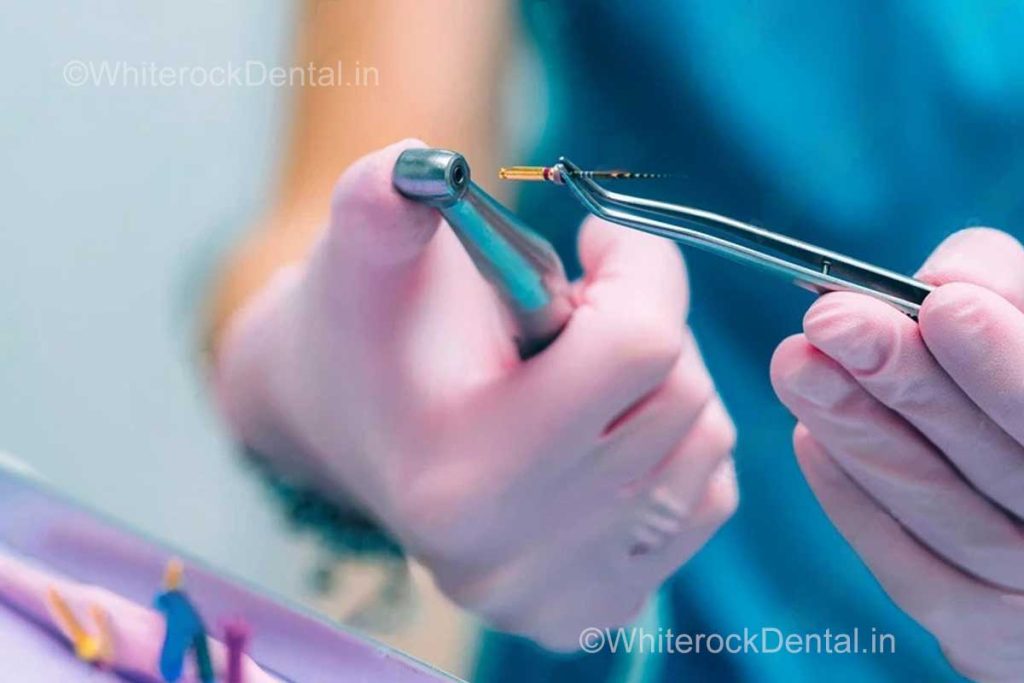
Step-by-Step Breakdown of a Standard Root Canal Treatment
-Dr Pauravi Hegde MDS
Hello, everyone! I’m Dr Pauravi Hegde MDS, a practicing dentist in Mumbai, and if you live in or around Sion, Chembur, Prabhadevi, Worli, King’s Circle, or Chunabhatti, you’re probably juggling a busy schedule. Between the local train commute, demanding work hours, and the lure of delicious street food, it’s easy to put off dental visits. Yet, one phrase that sends chills down most people’s spines is: Root Canal. Maybe you’ve heard rumors of it being painful or time-consuming. Well, let’s clear the air!
In this article, I’ll give you a step-by-step breakdown of a standard root canal treatment, explaining how it works, why it’s necessary, and what to expect. Trust me—it’s not as scary as it sounds, and it can literally save your tooth from extraction.
1. Introduction
Why Are We Talking About Root Canals?
Root canals often get a bad rap in popular culture. Folks imagine excruciating pain or an endless number of dentist visits. But here’s the truth: root canal treatment is a modern, near-painless procedure designed to save a tooth that would otherwise need to be pulled. If you’ve experienced severe tooth pain, especially from deep decay or an ignored cavity, a root canal is the treatment that removes the infection from inside your tooth while allowing you to keep that tooth in your mouth.
Anecdote: A college student from Worli once told me she nearly avoided all dentist visits after hearing a friend’s “root canal horror story.” By the time she mustered the courage to come in, her decay had spread quite far. During her actual root canal, she was shocked at how little it hurt and wished she’d come earlier. Her tooth is still going strong today, fully functional and pain-free.
2. What Is a Root Canal and Why Might You Need One?
Basic Definition
A root canal is a procedure where we remove infected or inflamed pulp tissue from inside a tooth. The pulp is the tooth’s core, containing nerves, blood vessels, and connective tissue. When decay or injury lets bacteria get in there, it can cause severe pain, swelling, or even an abscess.
Common Reasons for Root Canal
- Deep Decay: Maybe you’ve been ignoring that tiny black spot for months while indulging in sweet chai or mithai. Over time, that small cavity can evolve into major decay, reaching the pulp.
- Trauma or Cracks: Sometimes a blow to the tooth (like biting on an unexpectedly hard piece of chikki) can cause hidden fractures.
- Old, Large Fillings: If you’ve had repeated work on a tooth, it can weaken over time, letting bacteria sneak inside.
Local Dietary and Lifestyle Factors
Living in Mumbai means access to incredible food—from vada pav to gulab jamun—but these sugary or starchy treats feed oral bacteria. Combine that with hectic schedules that leave little time for brushing thoroughly or seeing a dentist, and you’ve got a perfect storm for deep decay. That’s where a root canal might become necessary.
3. Before the Procedure: Preparation and Diagnosis
Initial Examination and X-Rays
When you visit me, Dr Pauravi Hegde MDS, I’ll first do a visual exam. Perhaps we’ll gently tap the tooth or press the gums around it to see if you feel pain. We’ll take X-rays or a digital scan to confirm how far the decay or infection extends. This imaging often reveals if the infection has reached the root’s tip or if an abscess is forming.
Discussion of Treatment Options
If the pulp is infected, a root canal is typically the best solution to save the tooth. Extractions might be quicker, but then you’re looking at implants, bridges, or gaps that can shift your other teeth. I’ll explain the cost, the estimated number of appointments, and whether you might need a crown afterward for added strength.
Pre-Treatment Instructions
Usually, you can eat a light meal before the appointment—no need to starve unless you’re receiving sedation. If you’re anxious about pain, we’ll discuss sedation options or ways to calm your nerves. Most of my patients, after the procedure, wonder why they worried so much in the first place.
4. Step-by-Step Breakdown of the Root Canal Process
Now, let’s demystify the procedure itself!
Step 1: Local Anesthesia
We start by numbing the area around the tooth. Modern anesthesia is quite effective, so you’ll generally feel only a slight pinch when the needle goes in, and after that, you shouldn’t feel pain—only some vibration or pressure at most.
Step 2: Isolation of the Tooth
We place a rubber dam around the tooth to keep it dry and free of saliva. This might look a bit odd but ensures a sterile environment. It also prevents any irrigation fluids or debris from going into your mouth.
Step 3: Creating Access
Next, I’ll drill a small hole on the top or back side of your tooth to reach the pulp chamber. The idea is to create an opening so we can remove the infected or inflamed pulp. Don’t worry—you’re numbed up by now, so you’ll mainly sense pressure, not pain.
Step 4: Removing the Infected Pulp
This is the “core” part: using tiny files, we carefully clean out the canals, removing decayed tissue and bacteria. If it’s a molar, you might have three or four canals; a front tooth typically has one or two. This step can take a bit of time because we want to ensure no infected tissue remains.
Step 5: Shaping and Disinfecting the Canals
After the infected pulp is removed, the canal walls are shaped and smoothed. We also use antibacterial solutions to rinse out any lingering germs. It’s crucial to be thorough here—any leftover bacteria can lead to re-infection later.
Step 6: Filling and Sealing
Finally, we fill each canal with a rubbery material called gutta-percha to seal it off from further infection. A temporary or permanent filling goes on top, depending on whether additional steps (like a crown) are needed. And that’s the main procedure—your tooth is now free of infection!
5. Aftercare and Possible Next Steps
Placing a Crown or Final Restoration
If your tooth is weak (often the case after removing decayed pulp), we usually recommend a crown to protect it from fractures. This is particularly vital for molars, which handle heavy chewing. Sometimes, we place the crown in the same appointment if we use advanced CAD/CAM technology, or you might return for a second visit.
Post-Treatment Sensitivity and Care
Mild soreness or tenderness is normal. Over-the-counter painkillers, like ibuprofen, often handle any residual discomfort. Warm saltwater rinses can soothe the area. Most patients resume normal eating and speaking the same day, though I usually advise sticking to softer foods initially to avoid biting down too hard on that tooth.
Follow-Up Appointment
In some cases, we schedule a quick follow-up to ensure everything’s healing well—especially if you had a significant abscess or if multiple canals were infected. The dentist checks your bite and sees whether a permanent filling or crown is now stable.
6. Addressing Common Concerns
1. “Does It Hurt?”
Contrary to popular belief, a root canal typically doesn’t hurt—it actually relieves pain caused by an infected tooth. Once the anesthetic kicks in, you’ll feel minimal discomfort. In fact, many of my Chembur patients are pleasantly surprised at how straightforward it is.
2. How Many Visits Are Needed?
Often just 1–2 visits. A single visit may suffice if the infection isn’t too severe and we can finalize everything in one go. If the infection is more advanced, or if there’s an abscess to drain, you might need an additional session.
3. Is It Expensive?
Costs vary, but weigh it against losing the tooth entirely. An implant or bridge down the line can be pricier. Some dental clinics offer financing options—worth asking if cost is a concern.
4. Any Risks or Complications?
Re-infection can happen if bacteria remain or if the filling leaks. But with proper care and a skilled dentist (like me, Dr Pauravi Hegde MDS), your risk is low. Follow instructions, keep the area clean, and you’ll likely be fine.
7. Preventing the Need for Future Root Canals
Regular Dental Visits
Even if you’re caught up in the hustle and bustle of Mumbai life, aim for a six-monthly check-up. Catching a small cavity before it reaches the pulp is a big money- and pain-saver!
Proper Oral Hygiene
Brush at least twice a day with fluoride toothpaste, floss nightly, and consider using a mouthwash. If you live in Sion or Chunabhatti, pick up your supplies from a local pharmacy or supermarket—no excuses.
Addressing Small Issues Early
A tiny chip or a mild toothache after biting into a hard snack might seem trivial. But ignoring it could let bacteria in. The quicker we fix cracks or small cavities, the less likely you’ll need a root canal.
Anecdote: A mother from Prabhadevi brought her teenage son in after he complained about a slight twinge whenever he ate sweets. Turned out, he had a small cavity. A quick filling fixed it. Had they waited months, it might have worsened, eventually hitting the pulp and requiring a root canal.
8. Conclusion
Recap of the Process
- Anesthetic: You get numb.
- Access and Cleaning: Dentist creates an opening and removes infected tissue.
- Shaping and Disinfecting: Files and solutions ensure all bacteria are gone.
- Filling and Sealing: Canals are filled to prevent re-infection.
- Restoration: A temporary or permanent filling is placed, and often a crown follows to protect the tooth.
Encouragement & Final Thoughts
Today’s root canal treatments are faster, more comfortable, and more successful than ever. If you’re experiencing deep tooth pain or suspect you might need one, don’t put it off. In my own practice, I’ve seen countless patients from King’s Circle to Worli walk away pleasantly surprised by how routine the procedure actually is. They often say, “Why was I so scared?”
A root canal is about saving your natural tooth—which is almost always better than extracting it. With the infection gone, you’ll eliminate the pain and preserve your smile for years to come. So if you’re in doubt or notice persistent pain, schedule a consultation with your dentist. Remember, the longer you wait, the higher the chance the infection will spread—and the costlier or more complex the solution might become.


WhiteRock Dental Clinic
807 B, Lodha Supremus, New Cuffe Parade, Wadala East, Mumbai 400037, India
All content on this blog is copyright © 2024 by whiterockdental.in. Unauthorized reproduction or distribution is prohibited. For inquiries, please contact us via our website.
